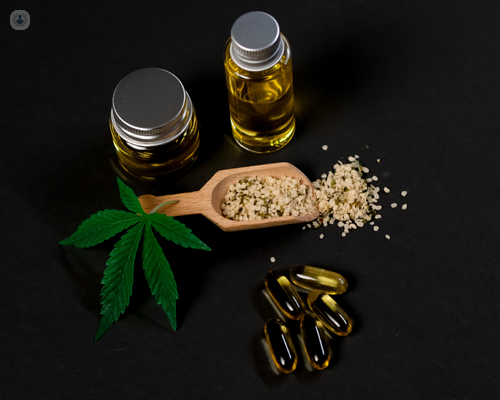Can chronic pain be treated with cannabinoids?
Written by:In addition to being a pain medicine and anaesthetic consultant, Dr Michael Platt is the medical director of award-winning London-based Sapphire Medical Clinic, which is the UK’s leading medical cannabis clinic, with clinics through England, Scotland, Wales and Northern Ireland. It is a multidisciplinary clinic that prescribes medical-grade cannabis for a number of different problems and that is visited by patients from around the country. Cannabis for medical use has been found to be safe and non-addictive and people of all ages find it helpful. Dr Platt explains what chronic pain is and how cannabis can be used to treat it.

What is chronic pain?
Chronic pain is pain that continues beyond three months. This definition came about because when post-herpetic neuralgia or nerve pain as a result of shingles, persisted over three months, it was deemed chronic. Now that has been generalised to cover any pain that lasts for an extended time.
Pain is an issue that affects the nervous system of the body. The makeup of your nervous system determines what sort of medication will help your pain. It also depends on what the problem is, how long you've had it and what your genetic makeup is. We all respond in different ways to medication and other interventions.
What is the difference between cannabinoids and conventional treatment of chronic pain?
Chronic pain tends to be neuropathic pain or nerve-mediated pain. The body's nervous system is extremely complex. There are between 85 and 100 billion nerve cells, that interact with each other by releasing chemicals called neurochemicals to activate the next nerve in the system. There are about 350 different neurochemicals that nerves can use to transmit pain. One of the ways we can treat neuropathic pain is by using drugs called anti-neuropathic pain medications which inhibit the release of neurochemicals and therefore the transmission. Other ways we can treat pain are by stimulating the nerves. As an example, radiofrequency can ‘reset’ the nerves and reduce their hyperactivity. Important factors to consider when deciding how to treat chronic pain are; the cause, when it has started, and why it continues.
In terms of cannabis, it is a treatment that can work when nothing else has. We know cannabis generally has multiple effects, one of which is on nerves. It can reduce nerve activity centrally as well, and that can help reduce the pain. CBD is an anti-inflammatory so it can reduce inflammation and is 30 times more potent as an anti-inflammatory than anything we have currently. Cannabis also helps muscles to relax so it's very good in patients with, for example fibromyalgia, multiple sclerosis or ankylosing spondylitis. Quite often, medical cannabis can be much better than any of the drugs we have currently available to treat these problems.
Do cannabinoids help with pain?
Cannabinoids help pain in a number of different ways, which we're still exploring. People have been using cannabis as a medicine for thousands of years. Queen Victoria used cannabis oil for her period pain, for example. It was banned in the 1930s in America because they were against it being used as a drug to make people high. Certainly, people do get addicted to the high and they often can’t do without it. Using medicinal cannabis, however, you don't get high on it and it's generally much safer.
One of the fascinating things about cannabis is the body's own endocannabinoid system, which wasn't discovered until the 1990s. It produces its own version of tetrahydrocannabinol, or THC, which is the molecule that makes you high if you heat it. The CBD oil, which you can get over the counter, works in a different way. There are two receptors in the body that are attached to the cells, CB1 and CB2. THC or the body’s own version is called Anandamide and attaches to CB1, while CB2 is what the CBD attaches to, or the body’s version called 2-AG made by the cells in the body. The more we look at the body's cannabis system, the more complex it is proving, and to disentangle it is proving very difficult. A lot of research is going on all around the world into how it works and what it does. Its main purpose appears to be to keep the body at homeostasis, meaning to keep everything balanced and controlled. It has evolved in the pain system and all the tissues of the body contain cannabis receptors, both CB1 and CB2.
In the medicinal cannabis that we use, rather than just using pure CBD or pure THC, we tend to use broad-spectrum oils which contain all the molecules from the cannabis flower, in excess of 500 different molecules. At least 8 of these are different cannabinoids, including THC and CBD. By using the broad-spectrum oils, but only controlling the amount of THC and CBD, we get a better effect, called the ‘entourage effect’, meaning all the molecules work together. For example, many of the molecules are what we call terpenes and it's the terpenes that not only give it that smell but also seem to work in the body in interesting ways that we're only just discovering now and they work with cannabinoids.
It is a very complex but interesting system in the body that illustrates how little we know about our own bodies.
Which cannabinoids are best for pain?
Generally speaking, THC works on the nervous system, centrally and peripherally, binding to the CB1 receptors. There are also CB1 receptors on the glial cells, the microglia, in the nervous system. The microglia modulate the nervous system, by controlling it and keeping everything up-to-date. And they also activate some of the pain receptors, particularly NMDA, which is the N-methyl-D-aspartate receptor, which is one of the key transmission points in the central nervous system. It is interesting that THC inhibits the microglial activation of NMDA and it may be one of the mechanisms by which it reduces neuropathic pain.
CBD is an interesting molecule because it combines with several different receptors and it seems to have many effects. It is anti-inflammatory and it also relaxes the muscles. In the different organs, it has different effects as well, which we're still unraveling and understanding how it helps pain. It also helps people to sleep. Difficulty sleeping is often one of the key issues with chronic pain, and if you're lacking sleep, you feel even worse. By helping you sleep better, you feel better, even if the pain is the same.
It works in a complex way in different systems and as time goes on, we'll learn more about how it helps pain and other things in the body.
Are there any side effects of using cannabinoids?
People react differently to cannabinoids and if they've never had cannabis before, the side effects are going to be more obvious. The main side effects are sleepiness and dizziness. Less frequently people get gastric nausea or stomach pain.
We have a tagline which is “start low, go slow”. We always start with a low dose and slowly titrate up, until the individual finds relief or starts getting side effects. We tend to start THC oil at night, about one milligram is the starting dose, so you sleep better and don't get sleepy during the day. The average spliff has about 10 milligrams of THC in it, for comparison. 10 milligrams of CBD oil are taken twice or three times during the day, to begin with. If you gradually increase the THC at night with no side effects and you're not getting to sleep during the day, you can take an extra THC dose in the morning, which helps some people who get a lot of pain during the day.
CBD and THC work better together so it’s important to take them both. Many people think they just need to take THC, but actually, you need both because they work in different ways in different tissues of the body. As we understand more about this complex system, we'll learn more about how it works.
Start low and go slow, and as you titrate it up, you get to the point where either the pain is eased significantly and you're sleeping better, or it’s having no effect. Some patients find that it doesn’t help the pain at all, but they aren’t getting any side effects either. This means they aren’t taking enough and their system needs higher dosage. In these cases, we need to increase the dose even more until we get to that point. The crucial thing is that everybody is different. There is no way of predicting how much a patient will need, which is why we start low and go slow.
If you are interested in booking a consultation with Dr Michael Platt, you can do so directly from his Top Doctors profile.


